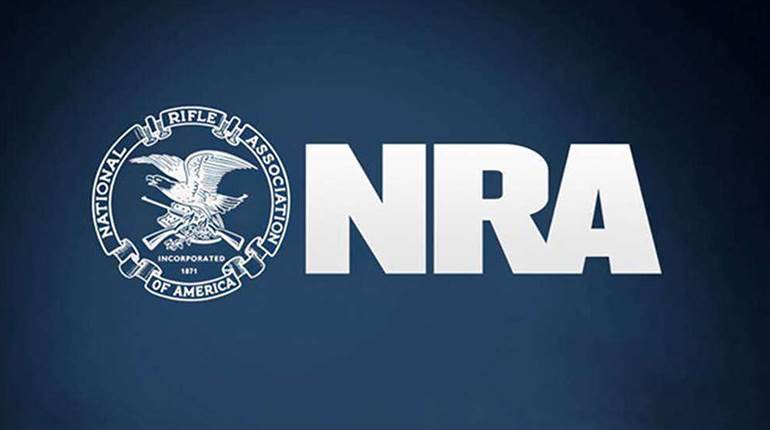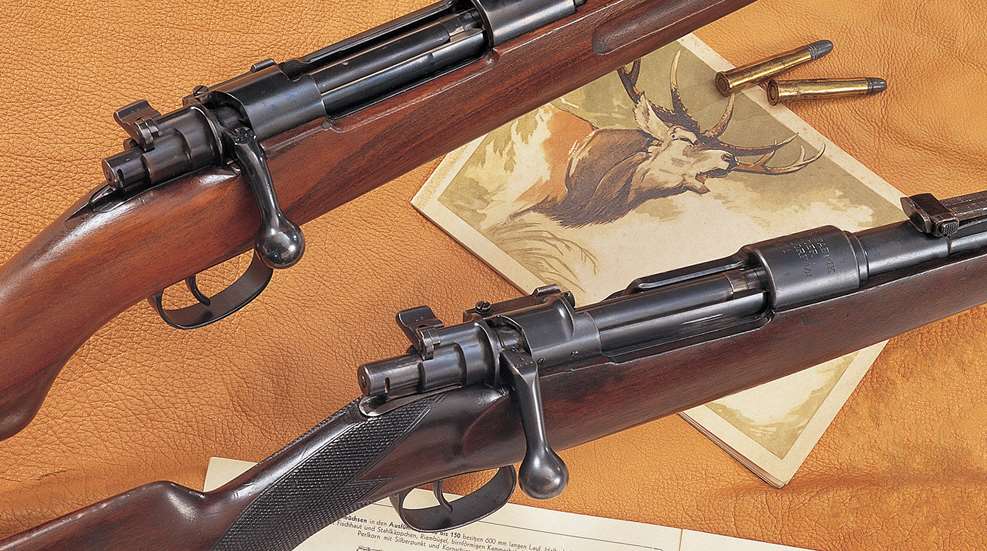
This article appeared originally in the January 2001 issue of American Rifleman. To subscribe to the magazine, visit the NRA membership page and select American Rifleman as your member magazine.
When Paul Mauser was developing his smokeless-powder rifles during the 1890s, he likely didn’t realize that his turnbolt design was destined to become world-famous and set the basic pattern for bolt-action military and sporting rifles of various other makes and models. It was a good example of success beyond expectation.
The culmination of Mauser’s efforts was his Model 98 rifle adopted by Germany in April 1898. Mauser 98 sporters were developed soon thereafter and were introduced at about the turn of the century. Made in rifle and carbine versions, they were produced by Waffenfabrik Mauser (Mauser Arms Co.) in Oberndorf am Neckar, a town in southwestern Germany, and are often called Oberndorf Mauser sporters.
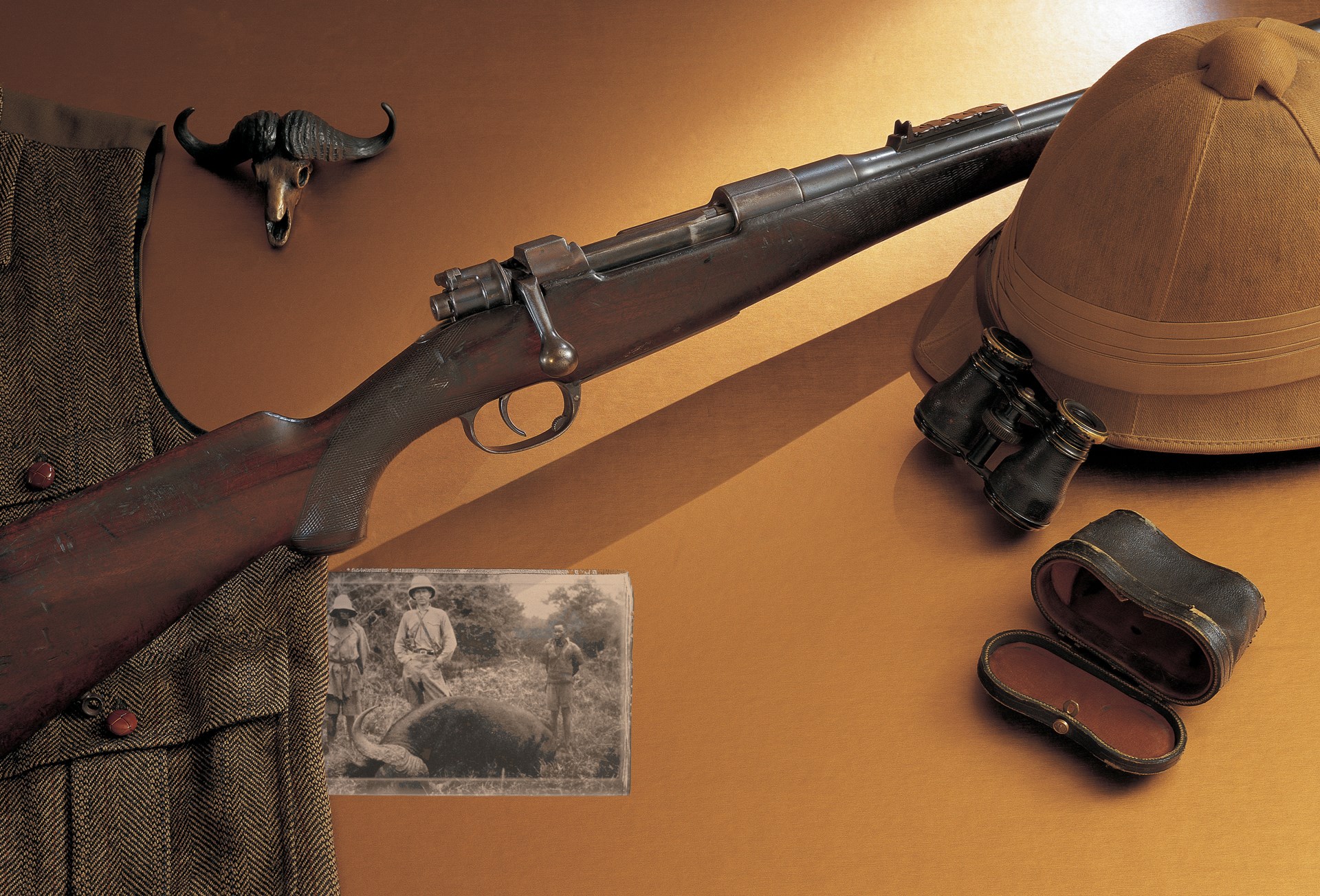 This well-worn Type A Mauser sporter in .404 Nitro-Express is typical of heavy-game rifles used in Africa. It has a British-type express rear sight with standard for 100 meters and folding leaves for longer ranges. This example is marked atop the barrel “Specially made for Chas. A. Heyer & Co., Nairobi.” Photo by Talmadge G. Rutledge. Rifle courtesy of the National Firearms Museum. Accoutrements courtesy of Phil Schreier.
This well-worn Type A Mauser sporter in .404 Nitro-Express is typical of heavy-game rifles used in Africa. It has a British-type express rear sight with standard for 100 meters and folding leaves for longer ranges. This example is marked atop the barrel “Specially made for Chas. A. Heyer & Co., Nairobi.” Photo by Talmadge G. Rutledge. Rifle courtesy of the National Firearms Museum. Accoutrements courtesy of Phil Schreier.
The Mauser firm calls them “genuine” or “original” Mauser sporters to set them apart from inferior rifles made up with factory-rejected or worn military parts. Most early original specimens are marked Waffenfabrik Mauser A.-G. (A.-G. Stands for Aktiengesellschaft, which means Limited or Inc.) on the receiver ring. Those produced later have the markings Waffenfabrik Mauser or Mauser-Werke A.G. on the receiver’s left wall. Some later specimens bear the Mauser banner trademark on their receiver rings. Mauser Co. markings are also on many original Mauser actions used by Rigby and various other reputable gunmakers that produced sporters. The popular term Mauser 98 sporter can be considered generic, but it is often taken to mean an original Mauser sporter.
Produced in a number of different calibers for hunting big game, original Mauser 98 sporters were offered in several types and varied in weight from about six to 8.2 lbs. depending on type and caliber. Within each type were various patterns with differences in sights and other details. There were also special sporters such as African-type rifles and the Spitzer-Bullet Model. Extra features for these sporters were listed in Mauser Co. catalogs and offered at extra cost. Many unlisted features were also available. With the wide selection of types and patterns plus extra features, these sporters were in the custom category, which makes them quite fascinating. Collectors coined phrases such as “They’re all different!” to express their enthusiasm.
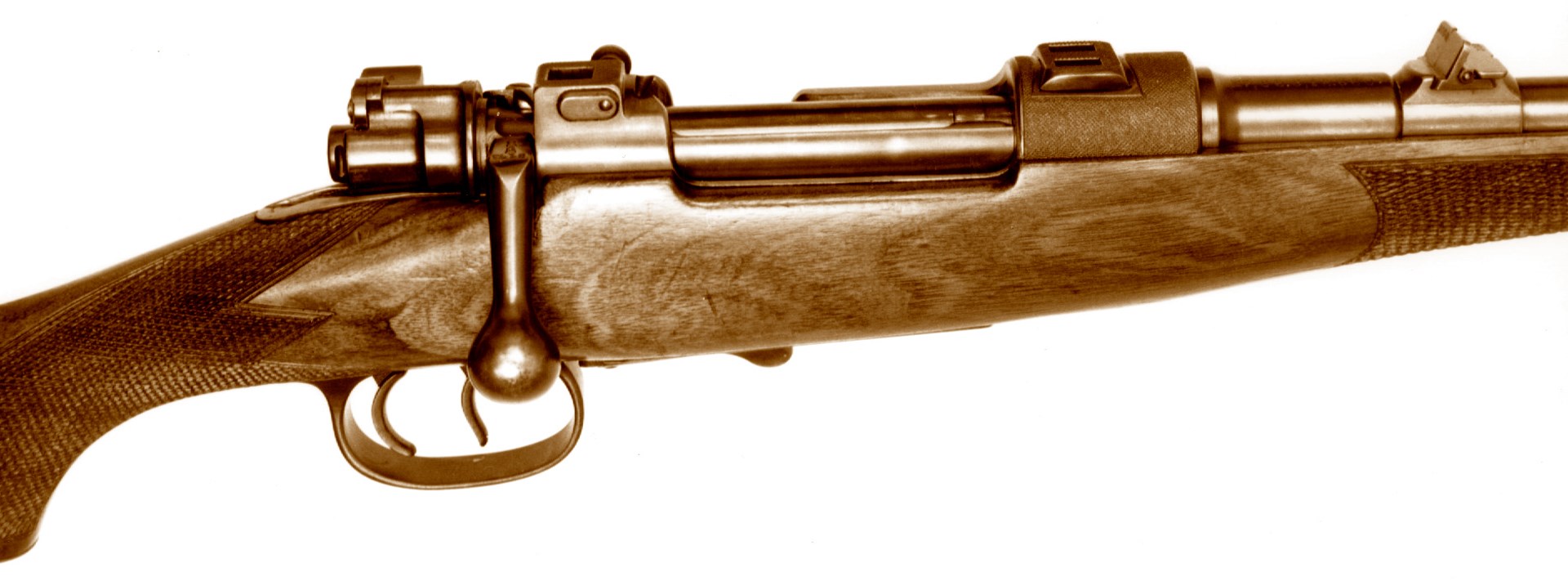 The front scope mount base of this Type B, Pattern No. 60 Oberndorf Mauser sporter is dovetailed into the receiver ring. The rear base is integral with the flat top of the receiver bridge. Photo by Lugwig Olson.
The front scope mount base of this Type B, Pattern No. 60 Oberndorf Mauser sporter is dovetailed into the receiver ring. The rear base is integral with the flat top of the receiver bridge. Photo by Lugwig Olson.
The Type B rifle, also called the normal (standard) model, was especially popular in Germany and is often encountered in the United States. It has Germanic styling and is often called the German rifle. Type A rifles were made chiefly for the British market and gave competition to high-grade British Mauser sporters. They have elegant lines and are especially well finished. Some are short rifles. Relatively short, lightweight rifles intended for use by persons of slight physique were dubbed Type K (K stands for kurz, which means short). They are similar to Type B rifles except for length and weight. Type M and S carbines are stocked to the muzzle in Mannlicher fashion. The Type S has Germanic styling and the Type M possesses several features of the popular Mannlicher-Schoenauer carbine. No-frills rifles made chiefly for utility were categorized as the Type C. They were offered at relatively low cost, but performed very well.
The list of metric calibers for original Mauser 98 sporters was extensive and ranged from 6.5x54 mm Mauser K to 10.75x68 mm Mauser. Other calibers were added later. They were .30-’06 Sprg., .250-3000 Savage, .280 Ross, 8x60 mm Mauser, .318 Westley-Richards and .404 Nitro-Express—also called .404 Jeffery. Some rifles were produced in various other calibers not listed in Mauser Co. catalogs. Presumably they were made on special order.
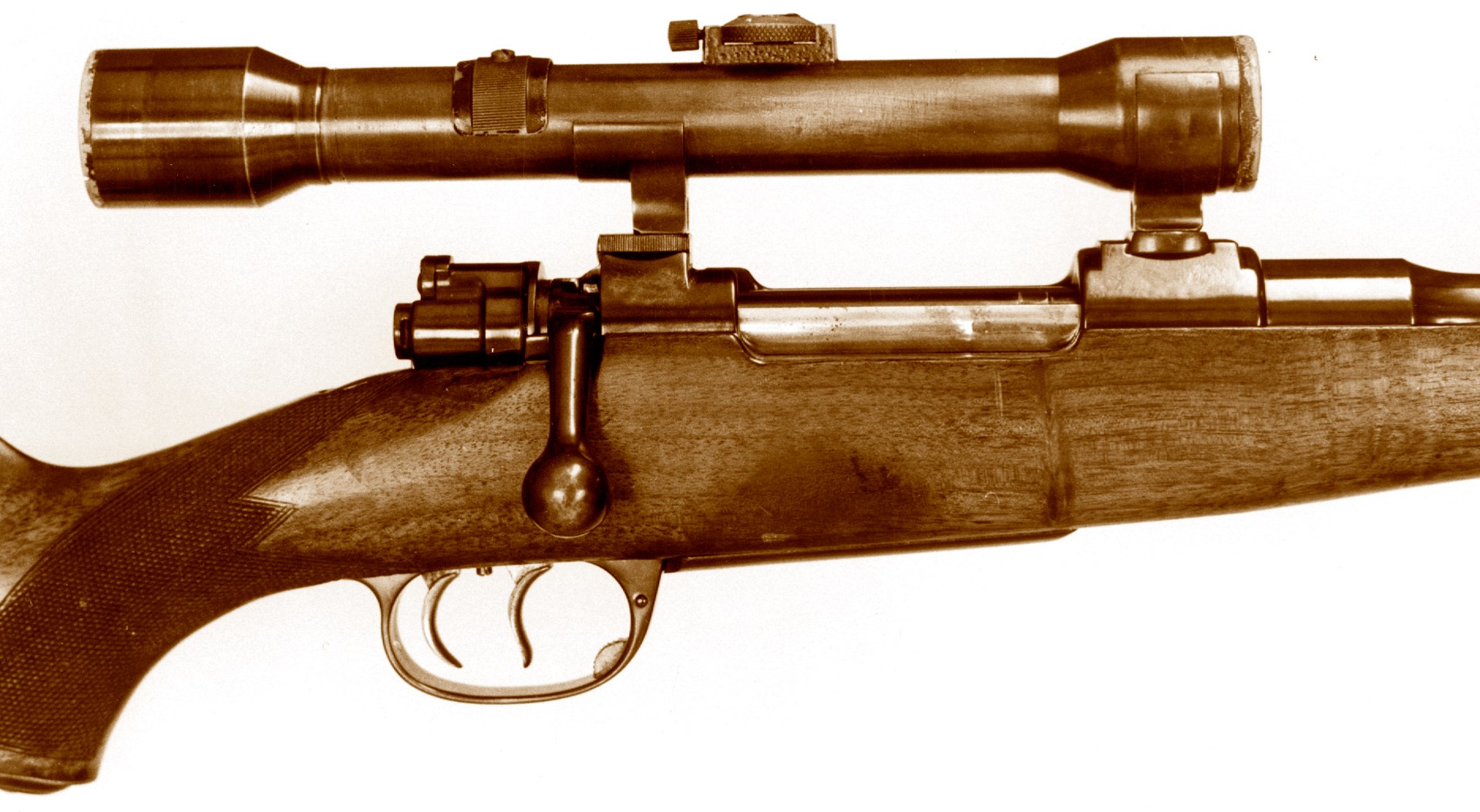 The Type B Mauser sporter (below) has a rear scope mount base integral with the receiver bridge, and the front base is fitted in a dovetail notch on the raised flat-top receiver ring. Photo by Lugwig Olson.
The Type B Mauser sporter (below) has a rear scope mount base integral with the receiver bridge, and the front base is fitted in a dovetail notch on the raised flat-top receiver ring. Photo by Lugwig Olson.
A very popular caliber for Mauser sporters was the 8x57 mm Mauser, also called 7.9 mm. Developed by a military commission in 1888 for the German service, this round first had a .318"-diameter, 227-gr., full-metal-jacket, round-nose bullet. Its official military designation was Cartridge 88, but it became known popularly as the 8x57 mm J (J is a German abbreviation for Infantry. It is used interchangeably with I). There was excessive bore wear and metal fouling with the Cartridge 88, but the problem was solved during the 1890s by deepening the rifling grooves.
A spitzer-bullet version of the 8x57 mm, called the S cartridge, was introduced for the German military in 1903. It had a .323"-diameter bullet to fit the barrel’s groove diameter, and the chamber neck diameter was increased. The new S Patrone used a 154-gr., full-metal-jacket, spitzer bullet of .323" diameter. The sporting version of this cartridge, made in various loads, has the commercial designation 8x57 mm JS (S is for Spitzgeschoss; spitzer bullet).
Two different bullet diameters for the 8x57 mm resulted in confusion. Mauser 98 sporters were offered in both sizes. Many German gunsmiths and hunters mistakenly regarded the smaller size, commonly called Normal (standard) caliber or J bore, more accurate than the 8x57 mm JS. The 8x57 mm JS cartridge should not be fired in 8x57 mm J rifles for safety reasons.
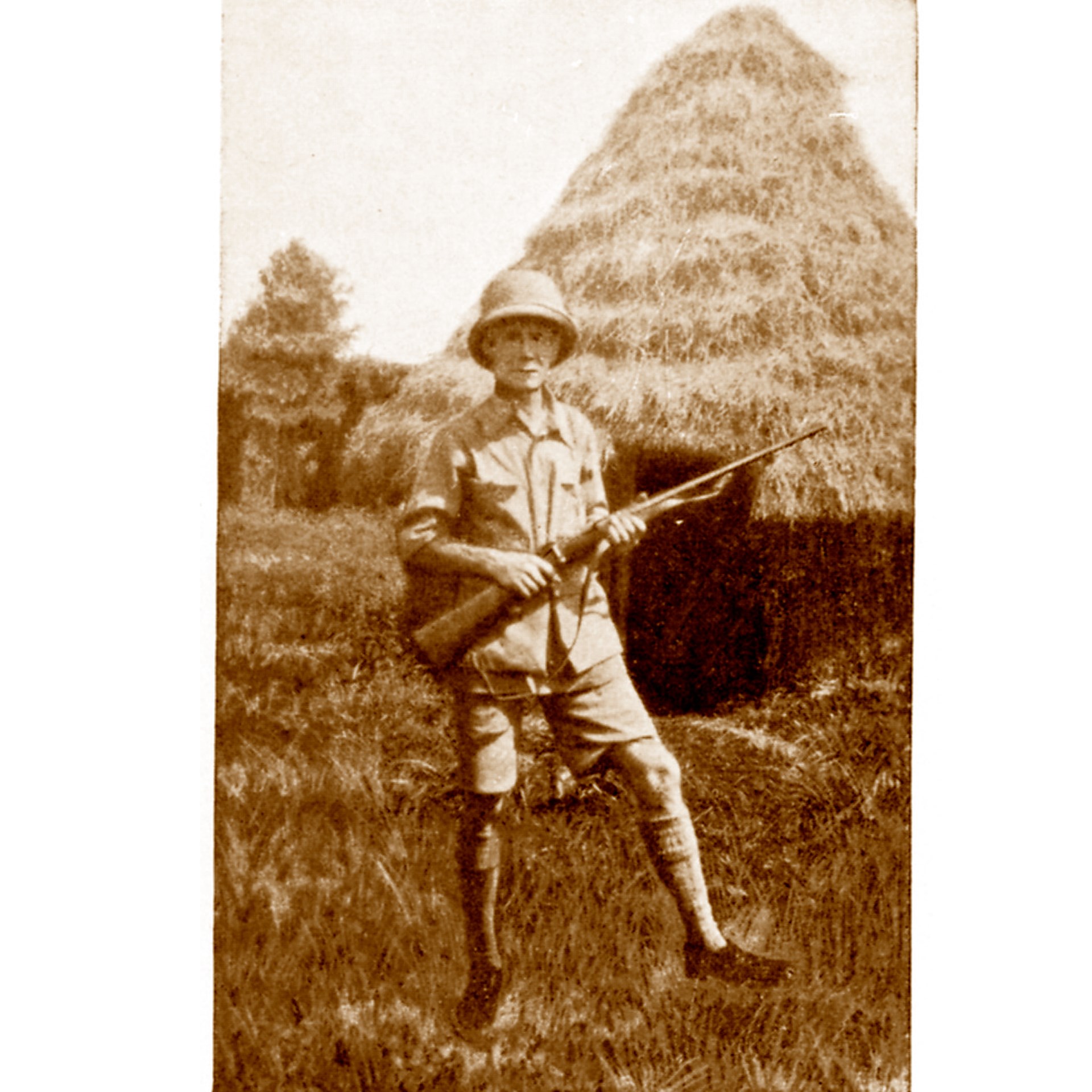
The standard rifling twist for 8x57 mm barrels is one turn in 240 mm (9.45"), but some 8x57 mm J-bore sporter barrels have one turn in 360 mm (14.17") to make them suitable for use with lead bullets. There were also 8x57 mm sporter barrels with six grooves instead of the normal four.
In accordance with the Versailles Treaty ending World War I, the 8x57 mm was prohibited for commercial arms in Germany after 1919. It was replaced for sporter use during the 1920s by the 8x60 mm Mauser cartridge that has a 3 mm longer case than the 8x57 mm J and JS and was made with the two different bullet diameters, .318" and .323". During the 1930s, the Germans resumed production of 8x57 mm sporters and cartridges.
Another very popular caliber in Mauser sporters was the 7x57 mm. It was first used in the Spanish Model 1892 military Mauser. Because of its good ballistic performance combined with relatively light recoil and excellent accuracy, it was known as the happy-medium size. Some confusion resulted because many 7x57 mm original Mauser sporters were marked “7,0N” or “7x57 N.” The “N” stands for Normal (standard) to indicate that the arm is sighted for the early original load with a 173-gr. round-nose bullet. A Mauser Co. catalog stated that if an S (spitzer-bullet) load is used, a different front sight is needed to correct the point of impact.
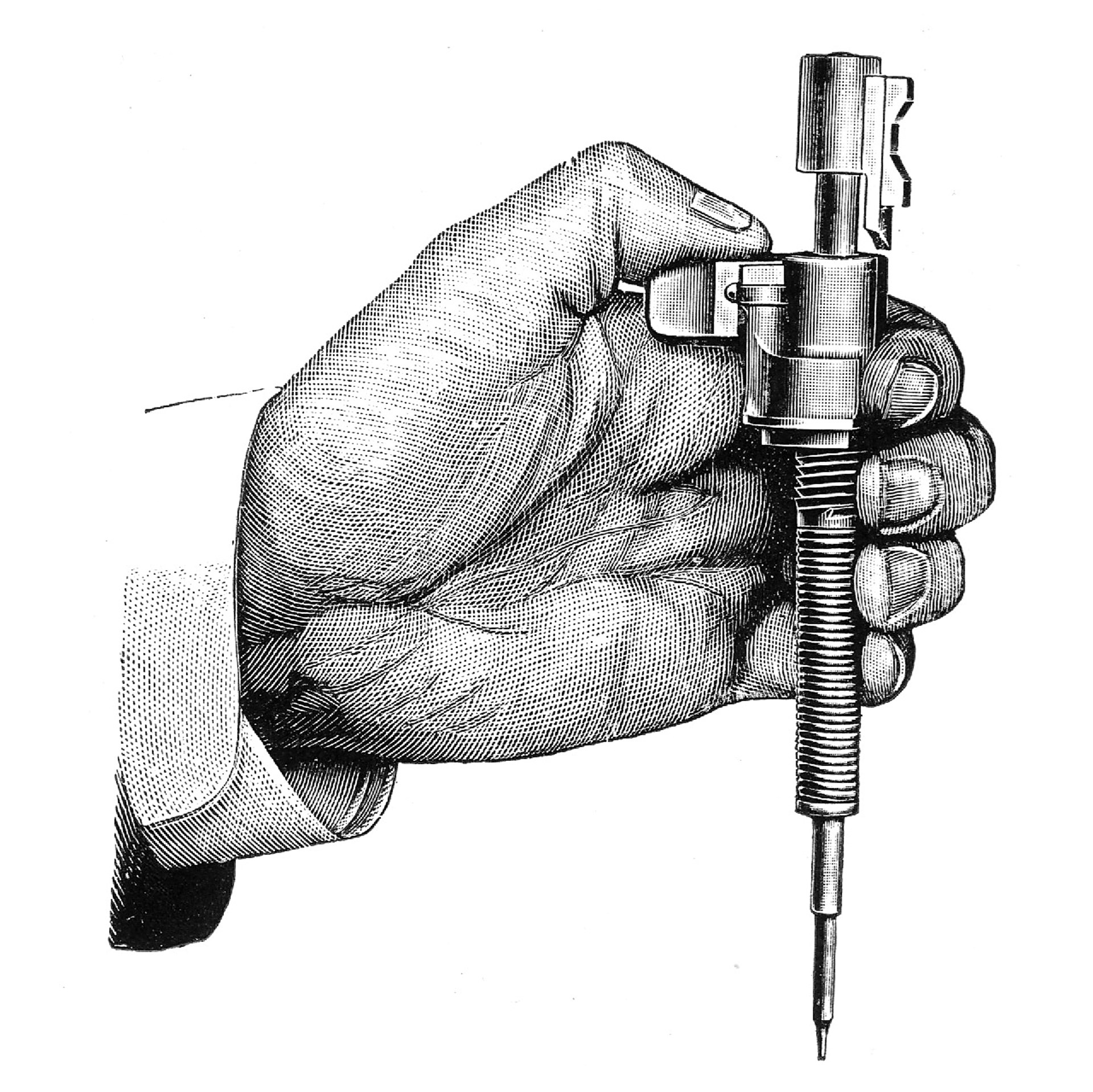
An excellent feature of these sporters is that their actions were made in different lengths to handle short, moderate-length and long cartridges. The medium-length action, 8.75" long, was used for the 8x57 mm, .30-’06 Sprg. and most other cartridges of moderate length. A short action of 8.13" length was used for short cartridges. The magnum action for long cartridges is 9.25" long.
A so-called intermediate action was commonly used for the 7x57 mm cartridge. It has the same overall length as the medium action, but its bolt is 0.2" shorter than that of the medium action, and its receiver ring is 0.2" longer. Its length dimensions match those of the Turkish Model 1903 and Peruvian Model 1909 military Mauser actions. A variation of this size, also made for the 7x57 mm, is often called the intermediate-reduced action by collectors. Its receiver ring is the same length as that of the medium action, and overall action length is 8.56". Receiver ring diameter is 1.30" for the short action and many early medium actions. Other actions have receiver rings of 1.41" diameter. The short action has lightening cuts on its receiver.
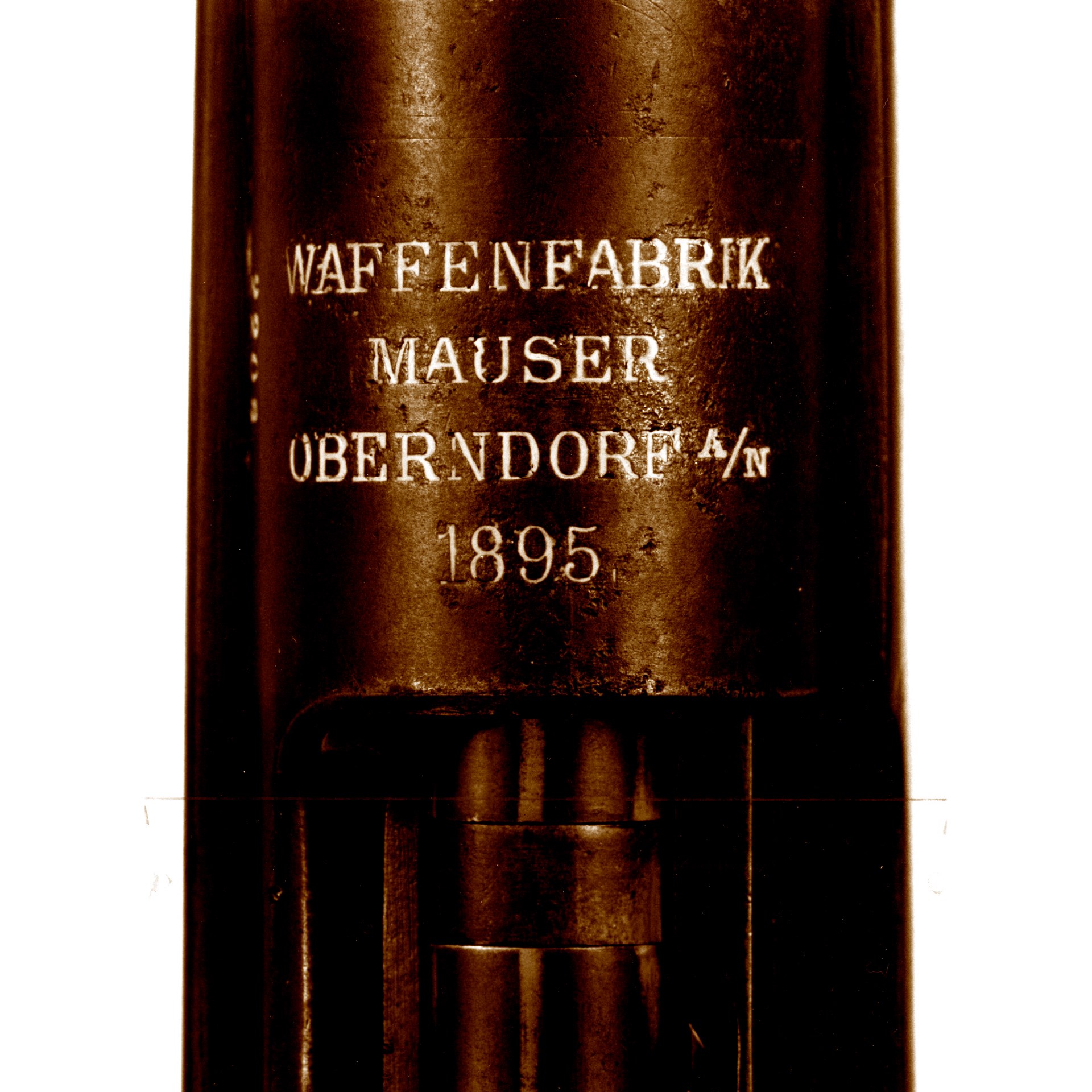 Most early sporters are marked “Waffenfabrik Mauser” (Mauser Arms Co.) and “Oberndorf A/N” on the top of the receiver ring with the year of manufacture below.
Most early sporters are marked “Waffenfabrik Mauser” (Mauser Arms Co.) and “Oberndorf A/N” on the top of the receiver ring with the year of manufacture below.
Early original Mauser sporting rifles were called Mauser-Repetier Puerschbuechse or C. 98/08 (Puerschbuechse means hunting rifle, and the C. stands for Construction or design). They have several unusual features. One is the early firing pin without lugs on the front of its mainspring flange. The lugs prevent firing if the firing pin would break with the bolt unlocked. Another feature is a military-type detachable magazine floorplate. Some rifles lack the bolt sleeve lock and have the early-type cocking piece with a pointed cam nose that engages a notch on the rear of the bolt. Other rifles have a bolt sleeve lock and a flat cocking piece nose. A cocking piece 5 mm (0.2") longer than that of the military Model 98 is a common feature of the early sporters. The small-diameter receiver ring is also common.
An early Mauser sporter, mentioned briefly in the 1910 Burgsmueller & Soehne catalog as Model 97, has a firing mechanism that cocks on closing the bolt. Its action is a transition between the Model 95 military Mauser and the Mauser 98.
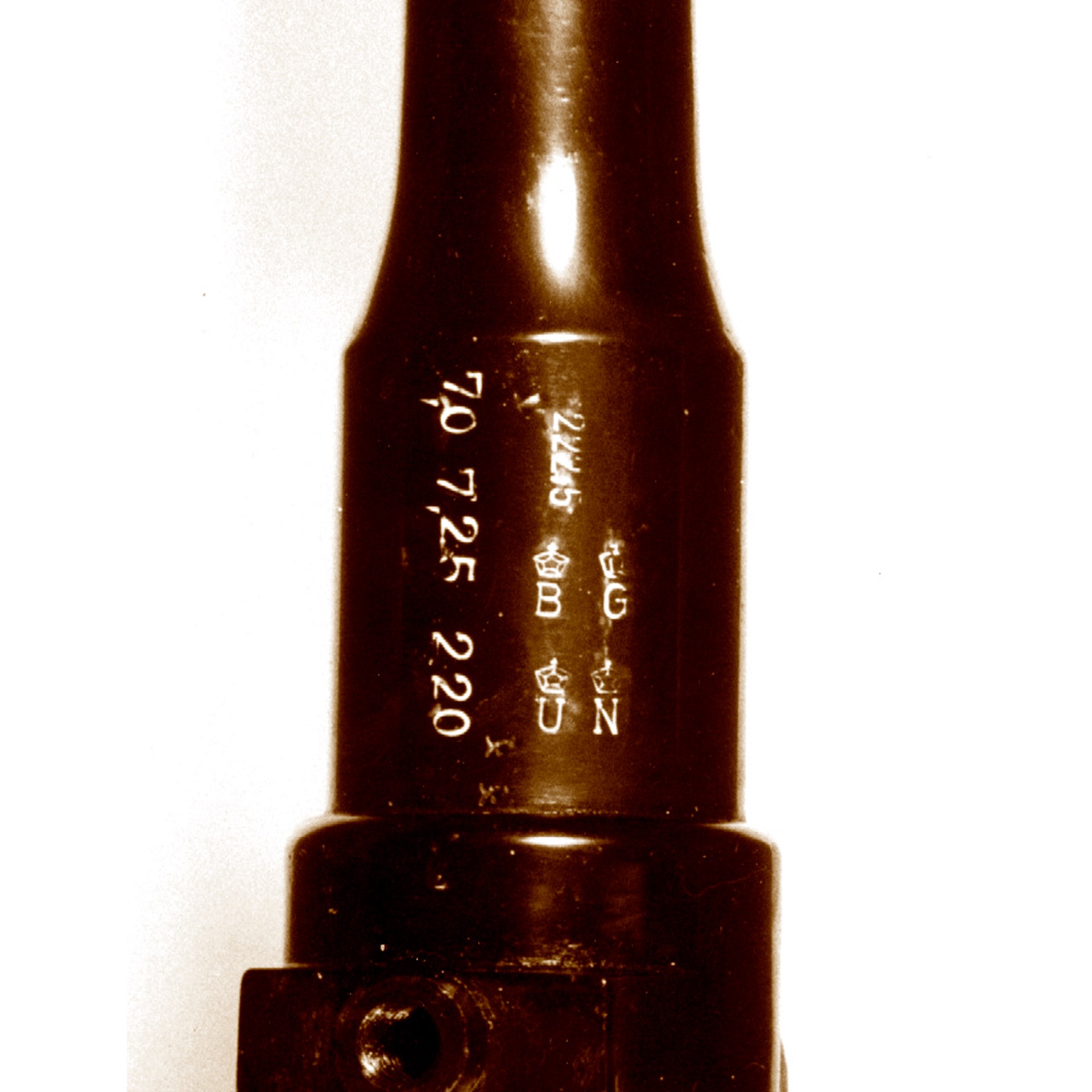 The numbers on this 7x57 mm Mauser Sporter’s barrel indicate “7,0” as the land diameter and “7,25” the groove diameter in millimeters. The “220” is the barrel’s rifling twist in millimeters.
The numbers on this 7x57 mm Mauser Sporter’s barrel indicate “7,0” as the land diameter and “7,25” the groove diameter in millimeters. The “220” is the barrel’s rifling twist in millimeters.
Another rare Mauser sporter with an action in the transition category is owned by an Ohio collector. Made for the 8x57 mm J cartridge, it has a medium-length action with small-diameter receiver ring. Cocking occurs on opening. Its receiver ring has the Waffenfabrik Mauser marking, but the year marking is 1895, three years prior to the introduction of the Model 98. The markings are like those on the German troop test Rifle 88/97 that has a tubular steel handguard attached on the front part of the receiver ring. It appears that a short steel bushing was fastened on the receiver of the sporter to cover the area where the steel handguard had been. Apparently a receiver left over from the Rifle 88/97 contract had been used for this sporter.
There were changes in the actions as production continued. One was the hinged floorplate that made it easy to unload the magazine from the bottom. The magazine catch is a quarter-turn lever on the floorplate or a push-type lever in the trigger guard. Another change was the later firing pin with lugs on the front of its mainspring flange to prevent firing if the firing pin broke when the bolt was unlocked.
Short, intermediate and magnum actions have relatively long, heavy cocking pieces—heavier than those of most medium actions. The cocking piece helps the firing pin support the primer during the period of high pressure. A relatively heavy cocking piece is thus appropriate on a magnum action, and it helps compensate for the somewhat lighter firing pins of short and intermediate actions. Some medium actions for high-pressure cartridges have long, heavy cocking pieces.
 Before World War I, the location of the Waffenfabrik Mauser marking was moved from the receiver ring to the receiver’s left side. The serial number is on the left of both receiver and barrel.
Before World War I, the location of the Waffenfabrik Mauser marking was moved from the receiver ring to the receiver’s left side. The serial number is on the left of both receiver and barrel.
Standard barrel lengths were 60 cm (23.62") for most rifles, 55 cm (21.65") for short rifles and 50 cm (19.69") for carbines. Round barrels with various contours were common, and full-octagon barrels with matte ribs were offered. A very popular barrel style for Type B and Type K rifles was the part-octagon and part-round style with a matte rib. Forerunners of that style can be traced back in Germany on wheellock guns.
Rifling is concentric type with right-hand uniform twist—four grooves for small and medium bores and six grooves for 9 mm and larger. As mentioned earlier, some 8 mm bores also have six grooves. Bores and chambers have a mirror-like finish. After the grooves were cut, the bore was lapped in a special machine. The chamber was made very smooth with burnishing reamers. A lead ball slightly larger than groove diameter was pushed by hand through the bore, and resistance was felt to check uniformity of diameter.
 (IRO A short action and 55 cm (21.65") barrel are basic features of Type 1: weight rifle, which was well-suited for persons of slight physique. This example is chambered in 8x51 nun K, a popular cartridge for use on European roebuck deer. Photo courtesy of Fred Reigle.
(IRO A short action and 55 cm (21.65") barrel are basic features of Type 1: weight rifle, which was well-suited for persons of slight physique. This example is chambered in 8x51 nun K, a popular cartridge for use on European roebuck deer. Photo courtesy of Fred Reigle.
Stocks were oil-finished walnut with greater buttstock length and drop than most American rifle shooters prefer. They were designed for shooting from the standing position. Type B and Type K rifles have skinny “toothpick” fore-ends usually flared out slightly at the front to form a schnabel (bird’s beak) tip. Early sporters have round-bottom pistol grips. Later ones have flat-bottomed grips capped with steel or horn. Buttplates are usually checkered hard rubber or horn with the Mauser banner trademark or fancy intertwined letters WM for Waffenfabrik Mauser. Rounded horn fore-end tips are common on Type A rifles. Hand-cut checkering is generally featured on pistol grips and fore-ends. Fore-end checkering was an extra-cost item on some rifles.
Ring-type sling swivel bases for specially designed detachable swivels are featured on Type A rifles. Other rifles have conventional loop swivels to fit a narrow carrying sling. The front swivel base is fastened to the barrel so that the rifle hangs low on the shoulder. That helps prevent the barrel from catching on brush and low branches. The downside to this feature is that sling pressure on the barrel can cause a change in point of bullet impact when using the sling to steady the rifle.
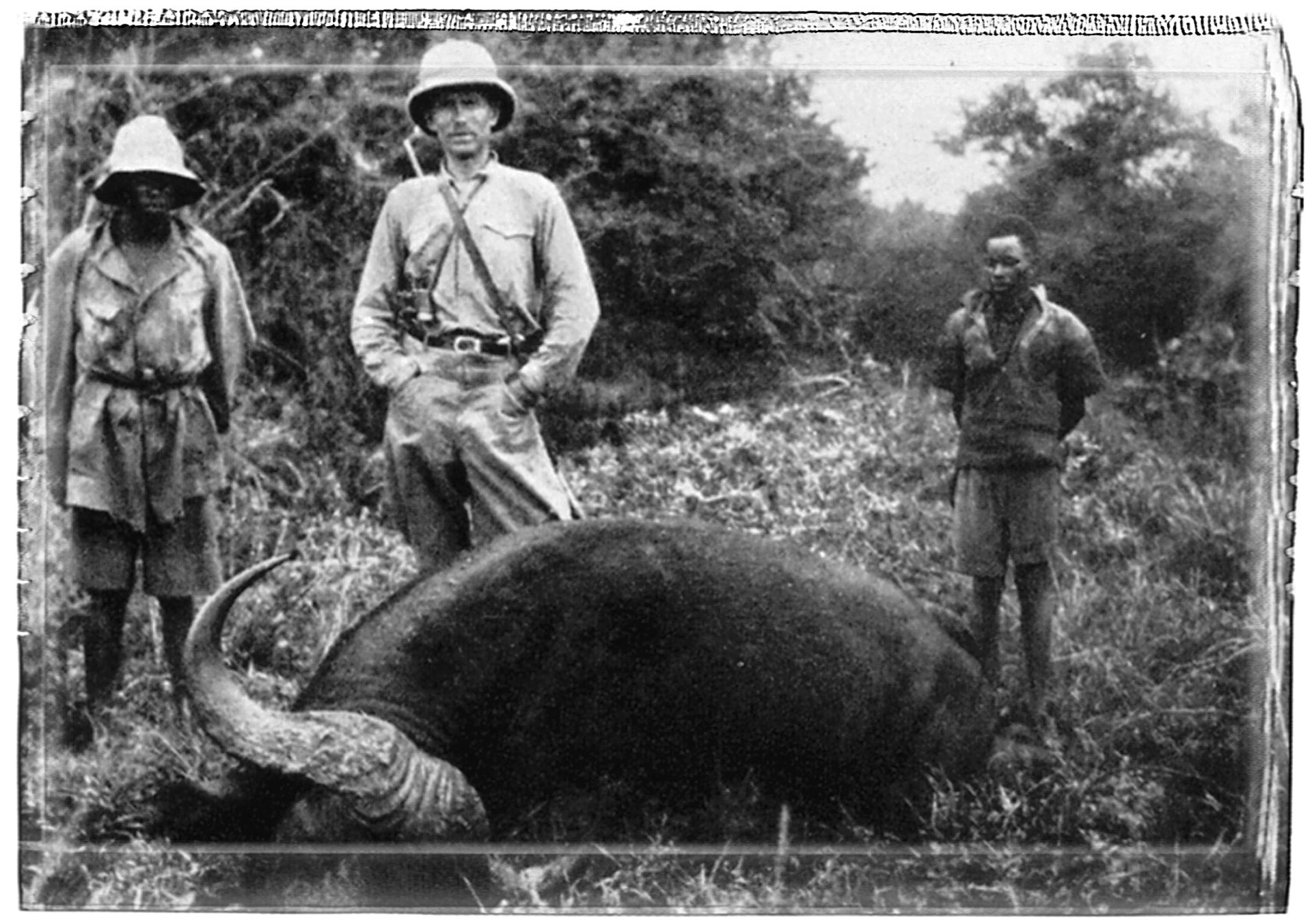 A silver bead front sight, usually on a long matted ramp, was standard. Various U-notch open rear sights were used. A popular type has a standard (fixed) sight for 100 meters and two folding leaves for 200 and 300 meters. An earlier sight of that type has the standard and one folding leaf. A sight of basically similar design was used on German rifles during the 17th century.
A silver bead front sight, usually on a long matted ramp, was standard. Various U-notch open rear sights were used. A popular type has a standard (fixed) sight for 100 meters and two folding leaves for 200 and 300 meters. An earlier sight of that type has the standard and one folding leaf. A sight of basically similar design was used on German rifles during the 17th century.
The tangent rear sight of military type with a leaf graduated from 50 to 1,000 meters was also popular. Type A rifles have the tangent sight or a British-style express rear sight with standard for 100 meters and folding leaves for longer ranges.
An added-cost option was a folding aperture rear sight fitted in a stock recess behind the receiver. It is pivoted rearward by the bolt and returned to its upright position by a spring as the bolt moves forward. When not in use, the sight can be locked back into its stock recess. It is fairly complex and was not very popular.
Mauser scope mounts, offered at extra cost, consist of front and rear mount members with scope rings. Claws at the bottom of the members engage recesses in bases on top of the receiver ring and bridge. The front base is on the barrel ahead of the receiver on some rifles. Both mounts are tunneled so that iron sights can be used when the scope is on the rifle. A windage-adjustment screw is in the rear mount, and elevation adjustment is on the scope. The scope mounts can be attached and removed easily from the bases without the use of tools.
 The styling of this 7x57 mm Type M carbine is similar to that of the Mannlicher-Schoenauer as made by Steyr. This one has a steel muzzle cap, flat bolt handle and a steel buttplate with a trap and storage recess. Photo courtesy of Ludwig Olson and Fred Reigle.
The styling of this 7x57 mm Type M carbine is similar to that of the Mannlicher-Schoenauer as made by Steyr. This one has a steel muzzle cap, flat bolt handle and a steel buttplate with a trap and storage recess. Photo courtesy of Ludwig Olson and Fred Reigle.
Some Mauser sporters have a raised flat-top receiver bridge with recesses for the claws of the mount. Both receiver ring and bridge have raised flat tops on some later sporters. A solid left receiver wall without a thumb cut is also a late feature.
The bolt handle is not shaped to clear a low-mounted scope, and the Mauser half-turn leaf safety also cannot be operated with a scope mounted low. A thumb-operated slide safety located at the right of the receiver tang was offered at extra cost. That was a big step in making low mounting of a scope possible. However, the Mauser Co. did not change the bolt handle to clear a low scope, except on some late sporters with specially-curved handles to provide lower mounting. The relatively high scope mounts are generally not favored by shooters, particularly Americans.
A traditional favorite with German hunters is the double set hair trigger mechanism often featured on Mauser sporters. Pulling the rear trigger sets the front one for a very light pull to avoid disturbing the shooter’s aim. The rifle can also be fired by pulling the front trigger without setting it, but the pull is much heavier. This complex trigger mechanism is confusing to use unless one becomes accustomed to it.
Many Mauser sporters have double-pull (two-stage) trigger mechanisms as used on military rifles. Also available was a single-stage trigger without the preliminary pull called slack.
The Type S carbine has a schnabel fore-end tip and a second schnabel farther back on the fore-end. Its bolt handle has a pear-shaped knob. A flat “butterknife” bolt handle, steel-capped fore-end and steel buttplate with trap are featured on the Type M carbine. Carbines were not made in 9.3x62 mm, 10.75x68 mm or .404 Nitro-Express because their 50-cm (19.69") barrels were not long enough for complete combustion of the heavy powder charges.
 The Type A rifle was the “Rolls Royce” of original Mauser sporters. This example has a tangent sight—most had express sights—and is chambered in 9.3x62 mm, a popular African big-game cartridge in its day.
The Type A rifle was the “Rolls Royce” of original Mauser sporters. This example has a tangent sight—most had express sights—and is chambered in 9.3x62 mm, a popular African big-game cartridge in its day.
Type C sporters were also called Army-Hunting rifles. They were introduced before World War I in 8x57 mm and various other calibers. A slightly higher-grade of the Type C is the Spitzer-Bullet Model offered in 8x57 mm JS and 7x57 mm. It is sighted for spitzer-bullet cartridges and marked "Spitzer-Bullet" on its receiver ring. An importer of these rifles and various other original Mauser spoilers was H. Tauscher, New York City. The principal importer following World War I was the New York firm A.F. Stoeger, Inc.
The African-Type rifle shown in Mauser catalogs has a 70 cm (27.56") barrel, and its fore-end extends to within about 4" from the muzzle. Some of these rifles have short wooden handguards. African-Type rifles were made chiefly in 7x57 mm. They are quite rare in the U.S.
Between the world wars, the Mauser Special Range .30-'06 Sprg. target rifle was advertised in Stoeger catalogs. Fitted with a handguard and stocked to the muzzle, this extremely-rare rifle has a 24" barrel. The only known specimen is owned by collector/author Jon Speed.
So far as can be determined from serial numbers, approximately 126,400 original Mauser 98 spoilers were produced up to May 1945 when World War II ended in Europe. A relatively small number were made up using remaining Mauser Co. parts after the war by Walter Roll who was head of the Mauser SportingArms Division for many years. Also, some were turned out by the Mauser Co. during the 1990s.
Although original Mauser 98 sporters are outmoded in several respects, they continue to be capable of effectively serving their intended purpose and provide considerable fascination for Mauser collectors. Above all, they deserve credit for having influenced the basic design of modern bolt-action spoilers produced by various armsmakers and custom gunsmiths.
Thanks to Peter Hardaway, Axel Eichendorff, Louis Kamfer; Dr. Pieter C. Van Rooyen, Jon Speed, Hugh Wilson, Mark Beck, Francis Kennedy, Michael flutter; and the Mauser Works.














